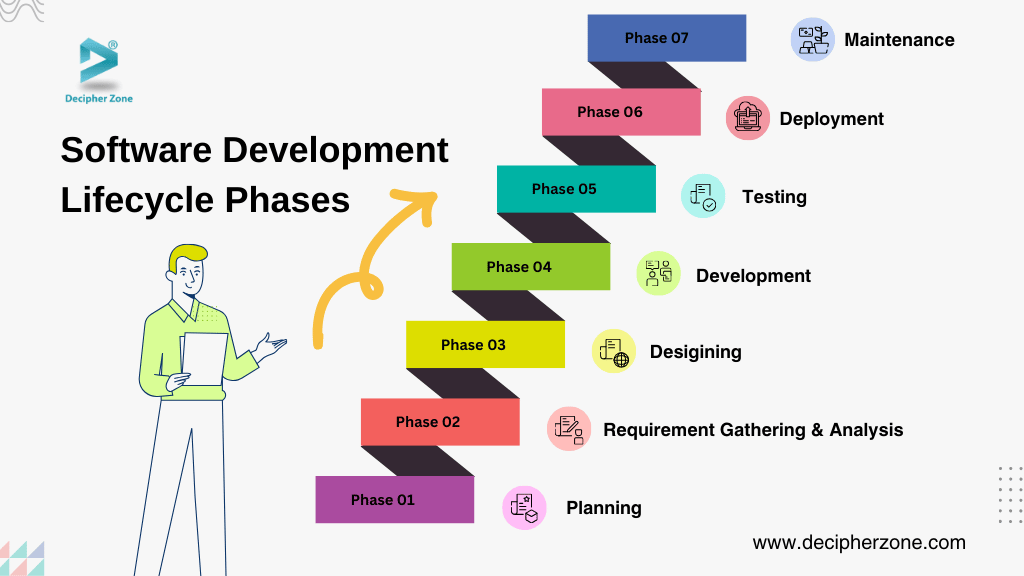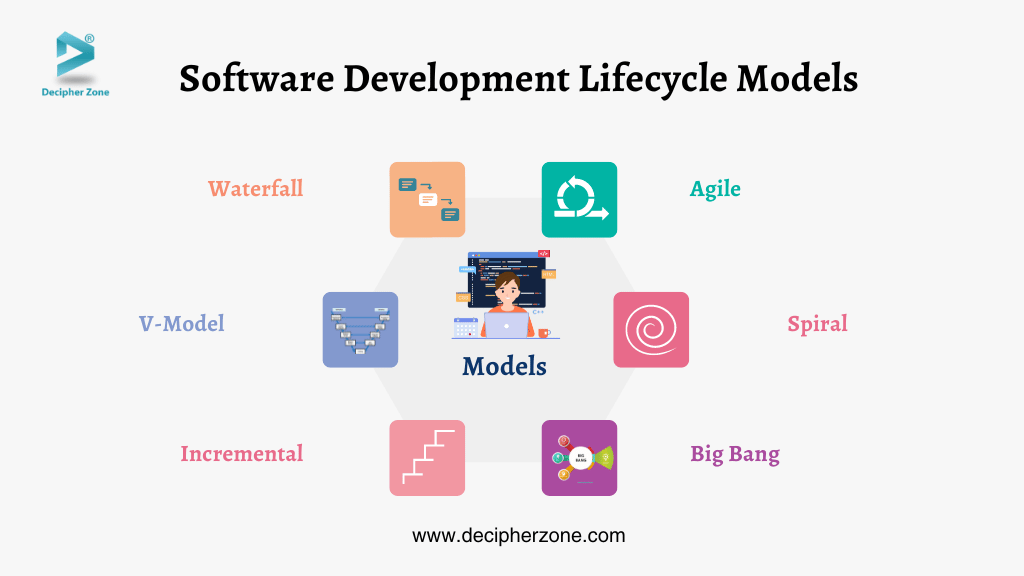It is essential to understand the phases and models of SDLC before handling any software project. This blog will delve into various aspects of the SDLC process to make it easier to comprehend. SDLC has been the cornerstone of the software industry, helping the development team manage and streamline the software development process.
Developing software is complex and intricate, demanding meticulous planning and execution. The development team relies heavily on the Software Development Life Cycle (SDLC) as a foundational framework.
This comprehensive methodology serves as an architectural blueprint, outlining the various stages and activities of software development. Its primary purpose is to guide the creation of high-quality software that meets the intended requirements and objectives.
Read: Best Software Development Models
Software Development Lifecycle: Phases and Models
In this blog, we will delve into the various aspects of the SDLC, explore its phases and models, and provide comprehensive insights into this essential framework for software development. The SDLC encompasses extensive key phases and offers developers a range of methodologies to choose from.
Defining Software Development Lifecycle (SDLC)
The software development lifecycle (SDLC) is a structured process development professionals use to plan, design, build, test, and deploy high-quality software solutions. SDLC aims to minimize project risks and ensure that the software meets industry and customer demands through careful planning and execution.
SDLC consists of well-defined phases that divide the development process into manageable tasks, which are then assigned to the development team, completed, and measured to ensure the project’s overall success.
Importance of Software Development Lifecycle (SDLC)
The Software Development Lifecycle (SDLC) is important in the software industry for several reasons. It offers a structured software development approach, which improves productivity, resource allocation, scheduling, and project management. Moreover, it promotes clear communication among clients, stakeholders, and developers to align the project with business objectives and effectively manage expectations.
By incorporating SDLC, businesses can ensure quality assurance, risk management, and regulatory compliance across various industries. Therefore, the value of SDLC lies in its ability to provide a systematic, methodical, and quality-driven approach to software development. Additional benefits of SDLC include improved capacity planning, enhanced project management, accurate cost estimation, thorough testing, flexibility, and shorter development cycles.
7 Phases Software Development Lifecycle (SDLC)
The Software Development Life Cycle (SDLC) is a framework that helps developers plan and execute the software development process. It aims to deliver high-quality software within a specified timeframe and budget. It achieves this by systematically identifying and addressing potential issues often arising during software development projects.
Moreover, SDLC involves a thorough assessment of existing software to identify and rectify any defects or bugs, ensuring that the final product meets rigorous standards of quality and reliability. Let’s delve into the various phases of the software development lifecycle in the next section.

1. Planning
In the project planning phase, the main focus is on defining the scope and objectives of the project. The development team is responsible for identifying the necessary resources and costs for the software application's development, assessing potential risks, and creating contingency plans. This phase evaluates the project's feasibility and strategies for successful implementation with minimal risk.
2. Requirement Gathering and Analysis
During the requirement gathering and analysis phase, all project-related information is collected from the client to aid in developing the product according to their needs. This phase involves resolving any ambiguities by arranging a meeting between the client and the business analyst to clarify the project's purpose and gain a thorough understanding of it.
Read: Software Development Challenges and Solutions
3. Designing
In this phase, the focus of software developers shifts to building the framework. They outline the functional requirements and aesthetics of the software. The designing phase outlines the software navigation, structure, database design, and user interface, ensuring the software is user-friendly.
Some of the key tasks involved in this phase are entity-relationship diagram development, data-flow diagram crafting, and mock-up creation while identifying integration points and other dependencies.
4. Coding
The coding stage of SDLC concentrates on converting the software design into actual code. During this phase, developers or programmers strive to create operational, user-friendly, and effective software using appropriate programming languages such as Java, PHP, etc., as well as the right tools and technologies under SDD.
Another important phase element involves regular code evaluations, where team members carefully review each other's work to detect bugs or inconsistencies. These thorough assessments uphold high code standards, ensuring the software's reliability and strength. This phase also involves initial internal testing to validate the software's functionality.
5. Testing & Debugging
Before releasing a software product into the live environment, it's crucial to conduct thorough quality assurance testing to ensure that it operates correctly, meets user experience and security standards, and fulfills all specified requirements. Accordingly, the testing and debugging phase includes various types of testing such as performance, functional, security, unit, usability, and acceptance to identify and eliminate any errors or bugs in the code.
6. Deployment
In the deployment stage, the thoroughly tested and efficient software is introduced into the production environment and handed over to the intended users. A specific approach is employed to ensure the smooth deployment of the software with minimal impact on user experience. Deployment involves more than just putting the software into operation; it also guarantees that users can use it easily.
This responsibility may include creating user guides, conducting training sessions, or offering on-site assistance. The deployment phase does not signal the end but rather a significant milestone. It signifies the transition from a project phase to a product phase, where the software begins to serve its intended purpose.
7. Maintenance
In the Software Development Life Cycle, the maintenance phase ensures that the software consistently meets customer expectations and adapts to changing needs. This phase involves providing ongoing assistance, integrating user feedback, resolving issues, and improving based on evolving requirements.
Maintenance tasks include updates, patches, bug fixes, and user support. Long-term strategies involve upgrading or replacing the software in line with its lifecycle and technological advancements.
6 Software Development Lifecycle (SDLC) Models
The software development lifecycle (SDLC) involves various models organizations use to guide development. Some of the most common SDLC models include:-
-
Waterfall model
-
Agile methodology
-
Spiral model
-
Big Bang model
-
Incremental model
-
V-Model

Each of these models offers unique approaches to software development, with its set of advantages and considerations. So let’s understand what these models suggest.
1. Waterfall model
The waterfall model is a software development approach that breaks the project into distinct phases. Each phase relies on the deliverables of the previous one, creating a cascading effect. As the process advances, tasks become increasingly specialized and granular. This method is most effective for small-scale projects with clearly defined requirements and limited uncertainties.
Read: How to Choose a Software Development Company
2. Agile methodology
The Agile model is a software development approach that involves breaking a project into smaller iterations and quickly delivering a working version. This iterative process allows feedback to be incorporated into each subsequent iteration, leading to continuous improvement. Agile is especially well-suited for projects that need the ability and flexibility to adapt to changes over time.
3. Spiral model
The spiral model is similar to the incremental model but strongly emphasizes risk analysis. It divides the project into phases including planning, design, coding, and analysis. This model enables iterative releases and continuous product improvement during each spiral phase. It also provides the flexibility to develop prototypes at every phase, contributing to a thorough and adaptive development process.
4. Big Bang model
The Big Bang Model is an unconventional development approach characterized by immediate and intensive coding with minimal pre-planning. Software requirements are addressed as they arise, without a predefined and structured project plan. It is best for small-scale projects that do not require planning.
5. Incremental model
The incremental model is a software development approach where the product is built and refined through a series of incremental stages. It involves designing, developing, implementing, and testing the product in small, incremental cycles until it is ready to be deployed, launched, and maintained. This approach is especially well-suited for large-scale and complex project systems where requirements still need to be understood at the outset and evolve.
6. V-Model
The V-model is a systematic representation of the software development process. It emphasizes a systematic and structured approach to software development. It involves verification and validation activities throughout each development lifecycle phase, ensuring that quality and reliability are maintained. This model is useful for creating well-defined development and project management plans.
Wrapping it Up
Before embarking on any project, it’s crucial to thoroughly understand the different phases and models of the Software Development Life Cycle (SDLC). Knowing the various SDLC models can help choose the most appropriate development approach for your project. Not only that it will also help streamline the development process and achieve excellent software solutions. Implementing SDLC provides a structured framework to guide the entire software creation process, ensuring timely and cost-effective project delivery.
If you are looking for a dependable software development company to help create the perfect software for your business, feel free to get in touch with us through our Contact Section today.
FAQs: Software Development Lifecycle (SDLC): Models & Phases
-
What are the different phases of SDLC?
Planning, requirement gathering, analysis, design, development, testing, debugging, deployment, and maintenance are the different phases of the software development lifecycle (SDLC) that a project has to go through.
-
What are the different SDLC Models?
Waterfall, Agile Spiral, Iterative, Big Bang, Incremental, and V-model are the most commonly used software development lifecycle models. You can choose the one that best meets your business requirements.
-
What are the advantages of implementing SDLC?
Implementing SDLC in your organization offers several benefits, including improved productivity, better resource utilization, proper scheduling, enhanced project management, clear communication, quality assurance, risk management, and regulatory compliance.

